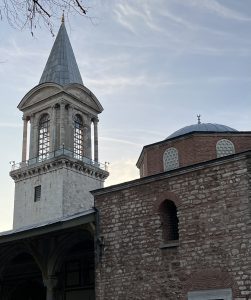Closed Tuesdays. Open 9am to 6pm. Admission to Palace including Harem and Aya Eirene: TL650 (TL500 without Harem), Turks TL140 (TL110 without Harem). Museumpass does not include entry to Harem or Aya Eirene
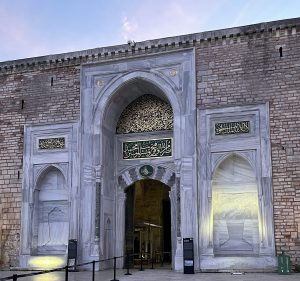 Of all the locations in İstanbul none could be more beautiful than the ridge above Sarayburnu (Seraglio Point) which looks over the confluence of the Golden Horn, Bosphorus and Sea of Marmara. Not surprisingly, then, it was here that the Byzantines built their palace (after a short interlude in what is now Kadıköy) and here, too, that the Ottomans built theirs. The Ottoman Topkapı Palace stands more or less on top of the Byzantine palace, a fact which has made its excavation difficult but which is constantly hinted at by the pieces of Byzantine masonry that dot the second courtyard.
Of all the locations in İstanbul none could be more beautiful than the ridge above Sarayburnu (Seraglio Point) which looks over the confluence of the Golden Horn, Bosphorus and Sea of Marmara. Not surprisingly, then, it was here that the Byzantines built their palace (after a short interlude in what is now Kadıköy) and here, too, that the Ottomans built theirs. The Ottoman Topkapı Palace stands more or less on top of the Byzantine palace, a fact which has made its excavation difficult but which is constantly hinted at by the pieces of Byzantine masonry that dot the second courtyard.
This is not a palace in the British understanding of the word but rather an Islamic palace suited to a Mediterranean climate, with assorted kiosks and porticoed buildings grouped round a trio of courtyards rather than one solid building. Those three courtyards also delineate different degrees of privacy, with the first one the most accessible to the ordinary Ottoman and the third more or less reserved for the sultan’s family.
Work on the palace was started by Mehmed the Conqueror in 1478 (before that he lived in the Eski Saray (Old Palace) in Beyazıt which is now lost) and it was named after a lost Topkapı (Cannon Gate) that was demolished in the 19th century. But the palace was always a work in progress with later sultans adding new buildings up until the time when they decided to move over to Dolmabahçe in 1856 as part of efforts to modernise the sultanate.
The first courtyard (Alay Meydanı or Courtyard of the Janissaries)
The two entrances to the palace from beside Ayasofya and beside Gülhane Park both lead into the first courtyard. The majority of people will enter through the Bab-ı Hümayun (Imperial Gate) across from the entrance to Ayasofya. The gate was remodelled in the 19th century but you can still the beautiful lunette filled with a Koranic quotation in lavish calligraphy by a man named Ali Sofi. A plaque below describes Mehmed the Conqueror as “the sultan of two continents and the emperor of two seas”. The niches on either side of the gate look pretty frilly after the remake but were originally used to display the heads of those who’d fallen foul of the sultan.
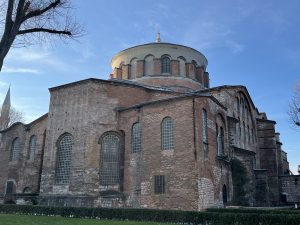 Once through the gate you’ll have to pass through a metal detector to enter the grounds. Perhaps unexpectedly the most prominent structure in the first courtyard is actually a Byzantine survivor, the enormous Church of Hagia Eirene (Divine Peace). Built in 537 on the site of an older church destroyed during the Nika Riot of 532, it was partly rebuilt in 740 after an earthquake and owes it survival since then to having found new use in Ottoman times as an arsenal and then as the first home of the Askeri Müzesi (Military Museum), now in Harbiye. Inside it is an austere building with a huge inlaid mosaic cross in the apse which also boasts the only stepped synthronon in the city. Now open to the public, it was not been improved by netting strung to deter pigeons. It’s also a shame that visitors can only peer through glass at the western courtyard which contains some fine Byzantine porphyr sarcophagi.
Once through the gate you’ll have to pass through a metal detector to enter the grounds. Perhaps unexpectedly the most prominent structure in the first courtyard is actually a Byzantine survivor, the enormous Church of Hagia Eirene (Divine Peace). Built in 537 on the site of an older church destroyed during the Nika Riot of 532, it was partly rebuilt in 740 after an earthquake and owes it survival since then to having found new use in Ottoman times as an arsenal and then as the first home of the Askeri Müzesi (Military Museum), now in Harbiye. Inside it is an austere building with a huge inlaid mosaic cross in the apse which also boasts the only stepped synthronon in the city. Now open to the public, it was not been improved by netting strung to deter pigeons. It’s also a shame that visitors can only peer through glass at the western courtyard which contains some fine Byzantine porphyr sarcophagi.
Along the wall run the buildings of the old Darphane (Mint), dating back to the 15th century but rebuilt in the 18th. It is not currently open to the public.
The ticket offices are at the far end of the first courtyard and are surrounded by fine çeşmes (fountains), now unfortunately roped off. In summer make sure to book online ahead of time to save standing in line.
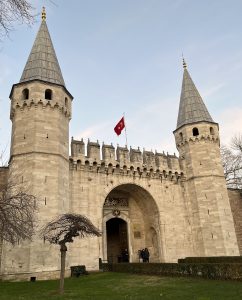 The second courtyard (Divan Meydanı)
The second courtyard (Divan Meydanı)
With ticket in hand you can pass through the Bab-üs-Selam or Gate of Salutations into the second courtyard. Grander than the outer Bab-ı Humayun, this entrance was designed to impress foreign visitors who would have to dismount here as only the sultan could ride through it. Above it is written the Shahada, or Islamic profession of faith: “There is no god but Allah and Mohammed is his Prophet”.
Out of season the second courtyard is a delightfully tranquil place shaded with cypress trees. Porticoes run along its sides and the lawns are dotted with fragments of Byzantine masonry while a piece of brick vaulting from a cistern is visible in the main path. To the left of the gate is the stable complex while to the right you can see some of the sultans’ carriages, the oldest an 18th-century landau. If you follow the portico round to the left an arch will take you through to the extensive kitchen complex adorned with a series of impressive chimneys visible on the Sarayburnu skyline. Here collections of the imperial kitchenware are on display with informative panels describing the use of less obvious items such as aşure testileri (jugs designed to hold aşure) and bozalıks (jugs to hold boza).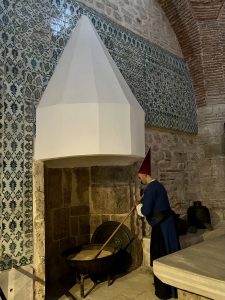
On the opposite side of the courtyard is the Divan or Council Chamber where the council of ministers would meet with the grand vizier sitting in the middle of them to discuss affairs of state; the sultan could listen in through a grille above the grand vizier’s seat. Above the Divan building (dating back to the reign of Sultan Mehmed Ii but largely remodelled in the 18th century) you’ll see the Tower of Justice, its conical roof another feature of the Sarayaburnu skyline. Divan Yolu, the main road through Sultanahmet, takes its name from the fact the ministers of state would process along it on their way to attend meetings here.
Next door to the Divan was the Public Treasury which now contains a collection of armour and weaponry. It was from here that the powerful Janissaries were paid every three months on a day called ulufe, some of their pay coming in the form of a meal which was served to them from bowls (çanak yağması) set on the ground, an extraordinary scene depicted in a painting by the French-Flemish artist, Jean-Baptiste Vanmour (1671-1737) and on display in the Pera Museum.
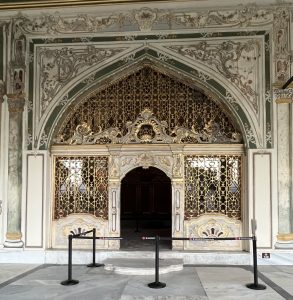
Harem (House of Felicity)
Access to the Harem is via a small door off the second courtyard beside the Divan. It leads into a tightly-woven network of tiled rooms, halls and courtyards where the women of the sultans’ households passed their lives. Parts of the Harem were constructed in the late 16th century during the reign of Sultan Murad III who preferred to move his family here rather than have them continue to live in the Eski Sarayı at Beyazıt. In 1665 a fire wrote off much of the Harem which was then extensively rebuilt.
Presiding over the Harem was the Kızlar Ağaşi (Chief Black Eunuch) whose rooms are just inside the entrance. The most important and powerful of the women was the Valide Sultan (Queen Mother), followed by the kadınlar (women) who came closest to being actual wives of the sultan and then the hapless cariyeler (slaves). The eunuchs ensured that not a breath of scandal could attach to the Harem; inside the entrance is a room for the Halberdiers with Tresses, men who wore their hair so long that they could use it to conceal their faces when they came to deliver wood here.
The sultan himself would have proceeded through the Harem along the Altın Yol (Golden Road) to its largest room, the Hünkar Sofası or Imperial Hall. This is elaborately decorated but could do with a bit of dusting. Against walls decorated with tiles imported from Delft in Holland, the sultan could sit on his throne to attend family gatherings, bayram get-togethers and wedding celebrations. A gallery added in the 18th century enabled blindfolded musicians to play to the guests.
More attractive is the Sinan-designed Salon of Murad III, constructed in 1578, its walls papered with İznik tiles and with a selsebil (elaborate fountain) to bring the soothing sound of running water into it. Off it open the Salon of Ahmed I with gorgeous blue and green tiles and the Yemiş Odası (Fruit Room) which was decorated with pictures of fruit and flowers for Sultan Ahmed III.
You exit the Harem via the Altın Yol which leads via the 18th-century Kuşhane Kapısı (Aviary Gate) to the third courtyard. Near here the Chief Black Eunuch, Süleyman Ağa supervised the strangling of the powerful Valide Sultan Kösem in 1651.
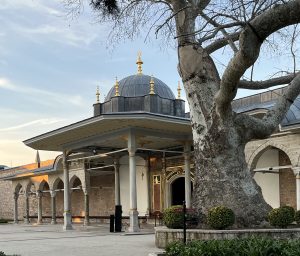 The third courtyard
The third courtyard
If you don’t access it through the Harem, you will enter the third courtyard via the domed Bab-üs Saade (Gate of Felicity) which dates back to the late 16th century but was remodelled with landscape paintings added to its canopy in the 18th century. Just inside the gate is the Arz Odası or Chamber of Pavilions, also known as the Throne Room, where the sultan would listen to reports of the meetings of the Divan and receive gifts from foreign ambassadors that would be placed in front of a window for his approval. It now contains a magnificently decorated throne along with a jewel-embroidered cushions and curtains.
Beyond the Throne Room stands the Library of Ahmed III (1719) with its stained-glass windows and mother-of-pearl-inlaid bookcases. On the right-hand side of the gate the Serefli Odası showcases many kaftans worn by the sultans that were carefully preserved after their deaths. A little further round and you come to a suite of rooms dating right back to the time of Mehmed II which now serve as Treasury offering an eye-watering glimpse of the wealth of the Ottomans in terms of gold and jewellery. Star items include the Spoonmaker’s Diamond, one of the largest diamonds in the world, and the Topkapı dagger, intended as a gift for a shah of Iran who died before receiving it, its hilt embossed with emeralds surrounded by diamonds. It shot to fame via the movie, Topkapı.
The Treasury is always heaving with visitors. Ditto the Pavilion of the Holy Mantle on the opposite side of the courtyard which contains some particularly holy Islamic relics including a standard and mantle brought from Egyot by Sultan Selim I after he captured the country in 1517. Before Sultan Murad III decided to live with his family in the harem this suite of rooms provided private apartments for the sultan. Nearby is the Chamber of the Royal Pages, an enclosed portico which displays portraits of the sultans, the majority of them copies. Only the portraits of the later sultans were made in their lifetimes.
The fourth courtyard
Beyond the third courtyard lie a series of terraces and gardens overlooking the best views from the palace. To the left is a garden which was used during the reign of Sultan Ahmed III for spectacular parties focussed primarily on tulips. The Head Physician’s Tower permitted the sultan to watch games of cirit (a form of polo) going on below him while the Sofa Pavilion allowed him to continue to appreciate the view even when it was raining.
Beyond the tulip garden lies the wonderful Marble Terrace, its centrepiece a fountain behind which the Iftar Canopy commissioned by İbrahim the Mad in 1640 allowed the sultan to break the Ramadan fast while soaking up the view. To the right of the terrace the lovely tiled Bağhdad Pavilion was commissioned by Sultan Murad IV after he captured Baghdad in 1639 while to the left is the Circumcision Room dating back to 1641 and linked by a tiled portico to the Erivan Pavilion commissioned by Murad IV in 1636 when he captured what is now Yerevan.
On the right-hand side of the fourth courtyard are the Sofa Cami commissioned by Sultan Mahmud II and the Mecidiye Pavilion designed by one of the Balyans c.1840 and now housing a branch of the Konyalı Lokantası (closed for restoration in 2024).
Transport info
Topkapı Palace is within easy, flat walking distance of the T1 Sultanahmet tram stop.
